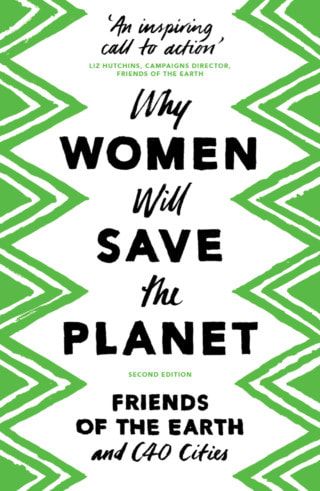Why Women will Save the Planet
The book is a collection of submissions by 32 women (including Lyla Mehta, a member of Green House’s Advisory Group) and 1 man who presumably, have all been asked for their thoughts on why women will save the planet. However, in my view that's not always the question their submissions have answered

Published by Zed Books, 2018
This is an updated edition of the 2015 publication with the same title. This new edition is a collaboration between Friends of the Earth - who were behind the 2015 version - and C40, who describe themselves as
“a network of the world's most important cities committed to tackling climate change”.
The chapters fall into three main categories. The first, and by far the largest group, present various arguments to the effect that any changes that will make women more equal in society will be good for the planet, but fail to show much of a causal link between the two. The second group reverse the question and are more successful in showing how preventing climate change will improve things for women, as women’s position in society is more vulnerable and they are therefore more severely impacted by the effects of climate change. The third, and to my mind arguably more interesting group, approach the debate from the point of view of economics and point out that the change in thinking that’s needed to give women equality is the same as that which is needed to save the planet - to stop commodifying everything. This would mean a radically different approach to mainstream economics. Vandana Shiva summarises the approach thus:
“We must redefine economic arrangements to include social externalities, like the impacts on women and ecological externalities.”
But externalities are precisely what mainstream economics refuses to deal with.
The idea that women and nature are both regarded by industrial society as resources to be exploited - to the detriment of both - is not a new one. Carolyn Merchant established the link in her book “ The Death of Nature: Women, Ecology and the Scientific Revolution” published by Bravo Ltd. in 1990, and “Why Women Will Save the Planet” continues the argument in a clear and accessible way over a number of chapters. Diane Elson argues that unless we challenge the idea of economic growth, we’ll achieve neither sustainability nor equality because the growth paradigm presents only a partial and severely flawed picture of the economy. She continues:
“The ability to take into account resources that are not marketed and not produced for profit, whether unpaid work caring for family and friends, or the atmosphere and oceans; not taking them for granted as ‘bottomless pits’, able to absorb any demands made on them; recognising both their importance and the distinctive value of not subjecting them to a commercial calculus - all this is central to the attainment of both women’s empowerment and environmental sustainability.” (p. 40-41)
Julie A. Nelson continues this theme, pointing out that neoclassical economics’ attempts to present itself as a “hard” science has led to the belief that it doesn’t depend on the natural world and is above social interdependence. She points out that conventional economics excludes the role of women and nature - looking at production for markets, not production for own use - and thus ignoring large and vital parts of human activity. Women and nature, she says, are pretty much invisible as actors in mainstream economics. Both are just treated as passive resources if they feature at all. But in reality the economy is actually part of nature and society, and we need to recognise this if we are going to change our economic behaviour to deal with the social and environmental problems we’ve created.
Lyla Mehta and Melissa Leach examine what a gender-equitable sustainable development framework might look like, in an attempt to address the issue of society’s exploitation of women’s unpaid care work and the environment as a never-ending source of productive inputs. In their view, feminists want a new system that stops prioritising the market and efficiency, and instead focuses on sharing, redistribution and “commoning”. They point out that the current system of production and consumption does not favour sustainability, but they caution against putting our faith in the green economy as a solution. They argue that it can actually harm the position of women and nature, since it is still a market-based approach that justifies the commodification and enclosure of resources, displacing local people, especially, they argue, women subsistence farmers.
A couple of authors - Vandana Shiva and Carina Hirsch in her joint contribution with David Johnson, the sole male voice in the book - point out women’s specific contributions to sustainability through the daily domestic tasks they perform, showing how women are acting as stewards of their environmental resources since their activities depend on them. Women, for example, are still growing produce for domestic consumption that has disappeared from the marketplace, and in doing so are preserving biodiversity, and the household tasks women perform in their environment (collecting water, gathering plants) make them a good source of knowledge for environmental management.
So when it comes to saving the planet, women - as the book points out - certainly have a role to play. But if you’re expecting a 200-plus page exposition of exactly how women are going to save the planet (as I admit I was), you’ll be disappointed. The economic arguments put forward by some of the contributors clearly have merit and are long overdue for serious consideration: we need to stop commodifying things - like women and nature - that simply aren’t commodities. If we’re going to find a solution that works however, climate policy needs to take account of everyone; saving the planet will require the efforts of women and men. Unlike a shared flat in a 1970s TV sitcom, the women can’t be relied on to clear things up after everyone’s had a good time trashing the place.



